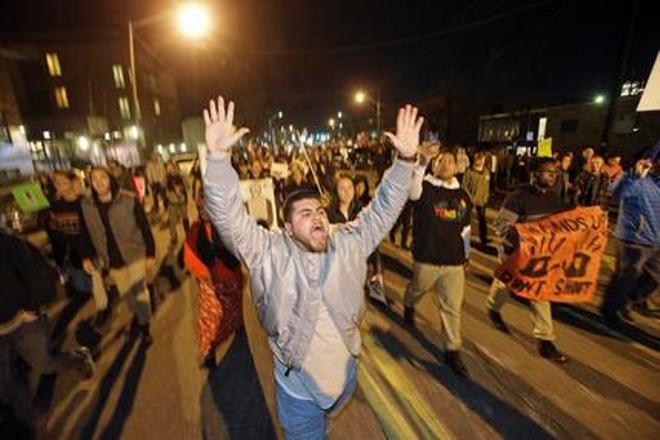
Wednesday March 2, 2016

Protesters take to the streets in Salt Lake City during rally and march for a 17-year-old boy who is in critical condition after being shot by Salt Lake City police Monday, Feb. 29, 2016, in Salt Lake City. Questions about why police shot and critically wounded the 17-year-old Somali refugee grew Monday as civil rights groups called for answers and several hundred protesters took to the streets. (AP Photo/Rick Bowmer)
advertisements
Police are refusing to release body camera video of Salt Lake City officers shooting and critically injuring a 17-year-old Somali refugee, fueling public outcry and leading some to call the decision on when to reveal such footage inconsistent.Footage from officers' body cameras is at the center of a national discussion about police use of force, especially with minority victims, and authorities around the country are working to decide when to reveal video from the increasingly popular law enforcement tool.
Twenty-three states have created laws for body cameras, many passed last year, according to the National Conference of State Legislatures.
Authorities have declined to release the footage from Saturday's shooting until they finish investigating. Keeping it private until investigators have sifted through the evidence to put the video in context is fairer to officers and the victim, said Unified Police Detective Ken Hansen, whose department is investigating.
Abdi Mohamed, who came to the U.S. with his family in 2004, was shot twice in the torso last weekend when officers tried to stop him and another person from beating a man with metal sticks, police said.
Officers told them to drop their weapons, but the teen moved menacingly toward the victim, authorities said. Mohamed remained in critical condition Tuesday.
The shooting stirred unrest Saturday in the city's bustling downtown, where about 100 officers in riot gear barricaded four city blocks as bystanders threw rocks and bottles. Hundreds of people turned out for a protest Monday, some carrying signs saying, "Stop killer cops."
The incident shows the lack of consistent guidelines for police body camera footage, said Anna Brower, spokeswoman for the ACLU in Utah.
"When police don't have a standard response for these kinds of situations, they put the public in a position of wondering, 'Why is it taking longer? What are you hiding?'" Brower said.
The case varies from another city police shooting that left a man dead last year, former Mayor Rocky Anderson said. The agency released video a day after an officer opened fire on a man who attacked him with a snow shovel.
"It seems very opportunistic to release the video when you think that it's going to appear in your favor, and then hold back the release when there's an obvious problem," Anderson said.
Because Mohamed survived, he could face criminal charges or sue the department, factors that may bolster the argument for withholding the video, said Connor Boyack, president of Libertas Institute, a Utah libertarian-leaning nonprofit.
But releasing it also could help quiet the backlash against police, he said.
Police have been tight-lipped on the details surrounding the shooting, leaving questions about why Mohamed was in the part of town that police regularly patrol to crack down on drug dealing and violence.
Mohamed's cousin Muslima Waladi told the Deseret News that Mohamed was a good kid but started getting in trouble after falling in with a bad crowd.
He had a juvenile history of a dozen offenses since late 2010, including theft, trespassing and aggravated assault with a weapon, court records show.
Mohamed and his family fled war-torn Somalia and arrived in the U.S. by way of Kenya more than 10 years ago. There is a relatively large community of refugees in Salt Lake City, where a strong economy and Mormon outreach programs can make it easier to find jobs and settle into a new life, said Deb Coffey, executive director of the Utah Refugee Center.
Refugees have to navigate transportation, schools for their children and learning English, which for some is their first written language.
"It's joyful and exciting, and there's also fear. It's hard," Coffey said.